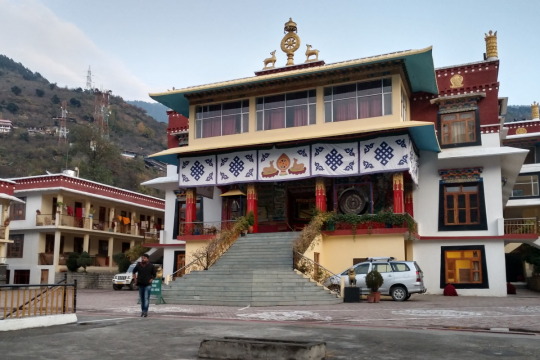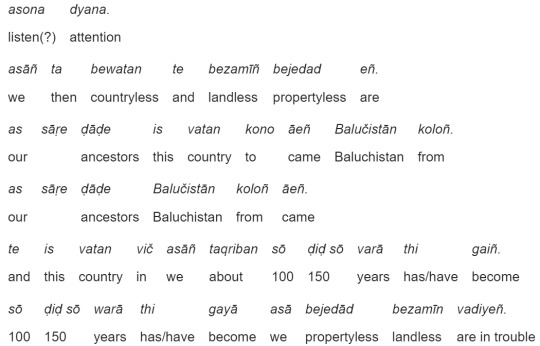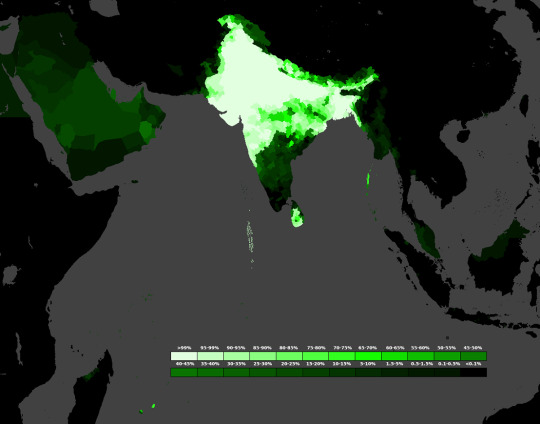#Indo-Aryan
Text
Iranians’ and Indian Muslims’ different relationships to European philology explain why the two conceived of their languages in such contrary ways. This divergence reveals the historical contingency of the two narratives. It was not inevitable that Iranian nationalism would adopt the philological model of linguistic continuity, which is made clear by comparison with Indian Muslims’ conception of Urdu as a mixed language.
This history leads to several conclusions.
First, what appears today as national culture – unique and discretely bounded – is the product of exchange with others from beyond the borders of the nation-state. This is certainly true of modern Iran. Nationalism, and what I call ‘Persianate modernity’, is the veneer that hides the very conditions of cosmopolitan cooperation and exchange that generated national culture in the first place. This suggests something about culture: it has no inherent politics, no predetermined trajectory.
Culture is an empty vessel that can be attached to all kinds of political projects. Cross-cultural exchange similarly can serve reactionary ends just as well as progressive ones. At the turn of the 20th century, exchange between Iranians and Indians served to alienate Indians from the history of Persian literature. More recently, the idea of Indian Muslims’ cosmopolitan origins has marked them as outsiders to India – a narrative adopted by India’s prime minister Narendra Modi and other Hindu nationalists to help marginalise and disenfranchise millions of Indian Muslims.
Nor is ‘indigeneity’ inherently progressive, a fact also illustrated by India’s Hindu nationalists. They now describe themselves as an indigenous population besieged by Muslim allochthones, ie foreign intruders. Indeed, we find the language of indigeneity taken up by ethno-nationalists elsewhere in the contemporary world – from the European Right, claiming to defend its indigenous culture against foreign refugees, to Jewish supremacists in Israel, who insist on their own indigenous roots in the land.
#persian#farsi#urdu#indo-iranian#indo-aryan#languages#asia#culture#south asia#west asia#islam#iran#india
12 notes
·
View notes
Text


Krishna and Arjuna, Bhagavad Gita
#bhagavadgita#bhagavad gita#krishna#arjuna#Hinduism#hindu#indian#asia#indo-aryan#asian history#battle#art
23 notes
·
View notes
Text
Dhakpo Shedrupling Monastery | Kullu Himachal Pradesh
Dhakpo Shedrupling Monastery | Kullu Himachal Pradesh
Dhakpo Shedrupling Monastery
The Himachal Pradesh location known as Dhakpo Shedrupling Monastery is home to a community of Buddhist monks. In the year 2005, the Dalai Lama presided over the opening ceremonies of the new monastery. The monastery, usually known simply as Kais monastery, is considered to be the crown jewel of Kais village.
It is one of the most popular tourist destinations in…

View On WordPress
#beas river#Dalai Lama#Dhakpo Shedrupling Monastery#Dhakpo Shedrupling Monastery kullu#Indo-Aryan#Kais village#kullu#Manali
0 notes
Text
AIT or Aryan Invasion Theory (debunked): A superior "race" of white, horse-riding Aryans invaded the areas of the inferior and primitive Indus Valley population, which included the Dravidians (but actually no one said that the IVC was a pure, dark-skinned Dravidian civilization so idk where that idea came from), and civilized them.
AMT or Aryan Migration Theory: A group of usually horse and chariot-riding nomads and pastoralists usually called the Aryans migrated from the Indo-Iranian region to India and mingled PEACEFULLY with the population of the late Indus Valley population (who were already highly advanced, as we know), by which time the IVC was beginning to collapse, possibly due to change of climate and rain patterns (still not sure yet), and hence the people were abandoning these settlements spreading across the subcontinent. These Indo-Aryans on arriving mixed with this population and shared their genetics, art and culture with each other, which led to the introduction of Sanskrit and Vedic culture in India.
To any leftist who keep regurgitating the former busted myth, please stop. You look stupid. And to any rightist who keep using AMT as AIT to debunk it, they're not the same. These two theories have a sky-ground difference.
The previous one makes Aryans look evil. That they were some high-level royalty who invaded India. But, in fact, they were regular people, regular migrants, just how every migration used to happen 3000-4000 years ago. Like I said, most of them were nomadic settlers.
Sure, later on, the varna system came into existence and this was the beginning of a hierarchical structure in India for the first time (since during the IVC there wasn't any sort of social hierarchy according to current sources). But who's to say it was ONLY the Aryans? Remember. They're NOT a race. They're a particular group of people. And by the time the varna system was introduced already a hell lotta intermixing had happened. Hence it wasn't JUST the Aryans (history and especially anthropological and genetic history is not that black and white LMFAO), because it was a term for 'noble', not some kinda "righteous clan" or something. Idk why people keep thinking of it as a race lol. I thought that was already debunked with the AIT.
As for the indigeneity of the Aryans, technically no one is indigenous. Many of the adivasi and non-adivasi tribes came AFTER the Indus Valley Civilization. So the "who came first" logic doesn't really work at all. (There might've been many that came before as well, who knows. Point is, again, it's all a migration salad at the end of the day)
adjective
indigenous (adjective)
originating or occurring naturally in a particular place; native:
This is the Google definition of indigenous. If we take THIS into account, there would be SEVERAL groups of people involved, instead of just one, like the IVC people, a few of the oldest nomadic tribes, mixed Indo-Aryans, etc. But I'm not gonna call ANYONE indigenous, or not indigenous. Because guess what, none of the humans are really indigenous to any place apart from the African continent. Also the Aryan migration led to the rise of a LOT of genetic subgroups, which was a key factor in leading to the most confusing anthropological history of the Indian subcontinent. It has a fuck ton of genetic markers and groups and subgroups, it's wildly confusing and historians are still trying to figure out every kind of intermixing that has happened. So STOP fighting over who is indigenous or not LMAO. Because guess what, we can never truly assert the indigeneity of a migrant species such as humans. (Yes we do call Native Americans the indigenous people of Americas, or the aboriginals the indigenous people of Australia and the Australasian archipelago, but they were also migrants at some point of time. Now before anyone says I'm disregarding the indigeneity of these groups, I'm not. All I'm saying is that we shouldn't CARE who's indigenous and who's not, because unlike the case of Americas and the Australasian islands, Aryans didn't INVADE India. They were simply another set of migrants, JUST like the IVC people, who also came from the middle-eastern region, and JUST like the adivasi tribes, who migrated from mostly the African and Australasian regions, probably, not sure again.)
I'll link the genetic studies done below because they explain it all way better than I can (and these research papers may also correct some of the incorrect statements I might've unnoticeably or ignorantly made in my own paragraphs so yeah):
Hence, at the end of the day, idk why we're banging our heads on the walls over ONE SIMPLE MIGRATION, which was NOTHING DIFFERENT THAN ANY OTHER MIGRATION. Migrations happen ALL THE TIME. Get over it, BOTH the sides of the political wings, and live in harmony lmao. The Aryans and Dravidians AREN'T RACES. They were just certain groups of REGULAR ass people jeez.
History is a complex subject, and the more evidence we find, the more we would know about our past. I have literally nothing against any of the political wings, but I do want to keep the current theories (which are NOT synonymous to hypotheses btw) and facts straight. I'm once again not saying these facts will never change, because that's not how history works. Maybe in the future, we might find out something completely different about India's past. But remember, whenever we talk about our country's past, we should keep it unbiased, unopinionated, and definitely factual and objective, without including our own views (both political and personal) into it. Interpretations? Sure. But they should remain at ONLY interpretations at best, and only the solid evidences should be claimed as facts.
#hindublr#aryan migration theory#indo-aryans#history#indian history#indus valley#indus valley civilization#desiblr#desi tumblr#desiposting#bharat
9 notes
·
View notes
Text
An ancient enigmatic fortress, known as Arkaim, has been dubbed the Russian Stonehenge and may be linked to the original Aryans.
30 notes
·
View notes
Text
The Inku Language
"Inku is an Indo-Aryan language spoken, at least historically, throughout Afghanistan by four of the country's nomadic communities: the Jalali, the Pikraj, the Shadibaz and the Vangawala.
Each of the four groups speaks a variety with slight differences compared to the others. According to their local tradition, their ancestors migrated in the 19th century from the Dera Ismail Khan and Dera Ghazi Khan regions of present-day Pakistan. Such an origin suggests that Inku may be related to the Saraiki language spoken there, though nothing is conclusively known.
The total population of the four Inku-speaking groups was estimated to be 7,000 as of the end of the 1970s. There is no reliable information about their present state, though it is unlikely that many have survived the subsequent upheavals in the country, and according to the entry in Ethnologue, which however may not necessarily refer to this language, the last speakers "probably survived into the 1990s".
Linguistic materials about the varieties spoken by the Shadibaz, Vangawala and Pikraj were collected by Aparna Rao in the 1970s, but they have not been published or analysed yet.
The following is an extract of a text narrated in 1978 by a man of the Chenarkhel subgroup of the Vangawala:

#the way i can understand most of this...#anyways this is all from wikipedia i havent had a chance to look at the references yet but there are a lot#i just couldnt contain my excitement at learning about a new language so i had to copy it all here for now#language#inku#afghanistan#indo aryan#dera ismail khan#saraiki#seraiki
5 notes
·
View notes
Text
Do you ever think about how we have completely bastardized what the terms “Caucasian” and “Aryan” are supposed to mean?
#Caucasian is from the region of Caucasia which is Georgia Azerbaijan and Armenia#aryan is the ancient indo iranians#language evolves whatever this is evolving in a bad way#unded rambles#language
7 notes
·
View notes
Photo

Distribution of Indo-Aryan Speakers & Diaspora
69 notes
·
View notes
Text
Learning Telugu as a Maharashtrian be like;
Mi means "I or me" in Marathi while it means "you or your" in Telugu.
*gives up immediately*
#JK I'm determined to learn this damn language#Na Peru Sakshi#SEE I'm fucking fluent#😭😭😭😭#send help pls#Like aren't we supposed to be neighbours why are our languages so different!!????#(ik it's because Marathi is an Indo-Aryan lang while Telugu is Central-Dravidian)#But STILL
86 notes
·
View notes
Text
*to the TMNT theme song*

PROTO-INDO-EUROPEANS
PROTO-INDO-EUROPEANS
PROTO-INDO-EUROPEANS
#im so upset tumblr refreshed right when i wanted to respond to a post pointing out those share the same amount of syllables#i know those arent PIE people but Indo Aryans but shhh#Art by Christian Sloan Hall
11 notes
·
View notes
Text
"indian is such an ugly language" 1. not a language 2. you are a tar pit
#if u've ever heard like. any of the dravidian or indian indo-aryan languages. u wld know that is not true#fisher's lake!
2 notes
·
View notes
Text
The first letter change from 'a' to 'i' in the words Andra to Indra and Aryan to Iran is a common phenomenon in Indo-Iranian languages called "Satemization." Satemization refers to the shift in pronunciation of the Proto-Indo-European (PIE) velar consonants (/k/, /g/, and /gʰ/) to palatal or postalveolar sounds (/s/, /ʃ/, and /ʒ/) in the Indo-Iranian branch of the language family. This change occurred in the Indo-Iranian language branch around 1500 BCE, which led to the development of the satem languages (such as Sanskrit and Persian) from the earlier centum languages (such as Latin and Greek).
#satemization#linguistics#sanskrit#iranian#avestan#hindi#indo european languages#languages#indo iranian#indo aryan
3 notes
·
View notes
Text
khatti (ancient Hittites of present-day Syria)
= kshatriya (warrior caste)/ khatri caste of punjab
not a coincidence that the first Sanskrit inscriptions were found in that region:
“the Hittites were never enemies in the Hebrew texts; in the Book of Kings, they supplied the Israelites with cedar, chariots, and horses, and in the Book of Genesis were friends and allies to Abraham” (wassup Brahma etc)
#india#south asia#punjab#kshatriya#warrior#caste#casteism#khatri#syria#hittite#ancient history#prehistory#pre history#sanskrit#vedic#aryan#indo european#brahmin#hindutva#jew#jewish#juda#israel#hebrew#abraham#brahma
3 notes
·
View notes
Quote
Soma ... exacts self-discipline of the priests, a long initiation and training: it is, for proper exploitation, an affair of a priestly elite. But the possible role of Stropharia cubensis growing in the dung of cattle in the lives of the lower orders remains to this day wholly unexplored. Is S. cubensis responsible for the elevation of the cow to a sacred status? And for the inclusion of the urine and dung of cows in the pancagavya (the Vedic sacrifice)? And was that a contributing reason for abandoning Soma? Given the ecological conditions prevailing in the Indus Valley and Kashmir, only a few of the Indo-Europeans could know by personal experience the secret of the Divine Herb. The cult of Soma must have been shaped by the peculiar circumstances prevailing in the area, but ultimately those circumstances must have doomed that cult. Today it lives on in India only as an intense and glowing memory of an ancient rite.
Terence McKenna, Food of the Gods
2 notes
·
View notes
Text
Finnish
orja /ˈorjɑ/
slave
From Proto-Finnic *orja (“slave, servant”), from Proto-Finno-Permic *orja, from Proto-Indo-Iranian *áryas ("Aryan": autonymic (self-identifying) ethnonym of the respective Indo-Iranian peoples, i.e. the Indo-Aryans and the Iranians).
Cognates include Estonian ori, Erzya уре (ure) and Udmurt вар (var).
WIKTIONARY
5 notes
·
View notes
Note
Is leon actually punjabi wait
yes! leon singh kennedy!
0 notes